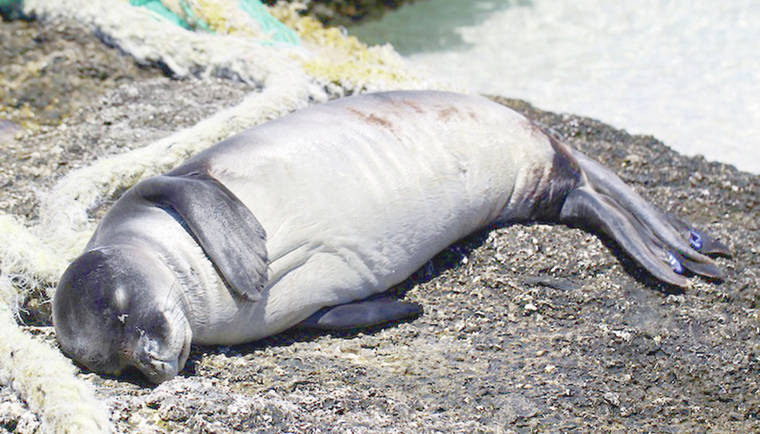LIHUE — Understanding fertility is paramount to understanding the real status of the endangered Hawaiian monk seals, researchers say. And new research out of Scotland could help inform ongoing projects in Hawaii.
Led by the Seal Mammal Research Unit at the University of St. Andrews, the newly released study was done on two populations of gray seals in the United Kingdom, one near North Rona and one at the Isle of May.
Basically, it helped fill in missing data on breeding patterns by tracking body-mass changes in captured pup-and-mother pairs.
That study started because university scientists had the same problem researchers in Hawaii face — the mother seals they monitor in two different colonies sometimes just disappear for a few months, seemingly skipping breeding years.
Unsure about what was happening with the seals during those years, scientists set to figuring out exactly what the gray seals are up to when they were off researchers’ radar.
“We found that mothers were probably breeding in around one third of ‘missing’ years, so this increased our fecundity estimates for both colonies,” said Sophie Smout, lead modeler on the study from the School of Biology at the University of St Andrews, in a press release about the study.
Researchers also looked at environmental factors as they relate to breeding in the two gray seal populations and found a difference: mothers in poor condition after breeding at North Rona didn’t regain mass as well as those at the Isle of May.
The study documented a marked decline in gray seal pups born at North Rona and an increase in pup numbers at the Isle of May, showing conditions on the Isle of May seem to be better suited for seal motherhood than at North Rona.
The bottom line is that reaffirms the importance of the seals’ environment in the breeding process.
“Long-term studies like this one are critically important, allowing us to understand how long-lived animals such as seals respond to environmental challenges,” said Paddy Pomeroy of the Sea Mammal Research Unit, in a statement about the study.
In Hawaii, National Oceanic and Atmospheric Administration research ecologist Stacie Robinson said researchers are also diving into a study about seal fertility and reproductive patterns — a study that should be released in the next few months.
“Some of the lines of thinking (in the St. Andrews research) are applicable to Hawaiian monk seals,” Robinson said. “We’re doing something that’s logically similar, but we’re using the patterns of our citizen science reports to get the information.”
Robinson said they’re not capturing seals and taking measurements for this study because researchers are aware of the sensitivity of the mother-pup bond in Hawaiian monk seals.
But Hawaii has a rich web of citizen scientists who monitor the seals and plenty of interested visitors and residents who report sightings on a regular basis. By tracking those sightings, researchers can put together a picture of the seal’s activity. Births are among data collected from citizen scientists.
“Birthrate is critically important to recovery potential of the species and definitely something we track closely in the Hawaiian Islands and in the Northwestern Hawaiian Islands,” Robinson said.
Counting pups and tracking births are a huge part of how researchers keep tabs on the monk seal population and are part of what researchers call “vital rates,” or the big indications of population status. Those include things like survival rates and reproduction.
Robinson couldn’t give out any more information about the study, which is being finished and readied for review.
Meanwhile, she wanted to remind the public that reporting sightings really does help inform research.
Any monk seal sightings should be reported to NOAA Fisheries via the Monk Seal Hotline at 651-7668.
•••
Jessica Else, environment reporter, can be reached at 245-0452 or jelse@thegardenisland.com.


